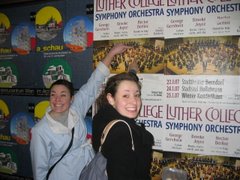About Me
Links
Blog Archive
Sunday, March 11, 2007
What place does technology have in the classroom? I think that, whether we like it or not, in a world where technology is becoming more and more important, teaching technology should become more and more of a priority. When our kids get out into the real world, they need to be able to know how to use a computer or other basic skills that are becoming necessary for everyday life. And when it comes to using technology in the classroom as a tool for learning, I think it's a great idea. Technology can enhance the learning process in many ways. First, things like blogs and websites can enhance parent-teacher and student-teacher communication, something that is too often overlooked. Technology can be used to give kids examples to listen to at home for music classes. Interactive math drills can be found on the internet. The number of great resources on the internet is vast. My only hope is that kids don't get hooked on technology and start using it as a crutch. I hope kids can spell without spell-check and go to the library and look up a book for a research project, rather than just typing the subject into Google, although both these tools, when used right, are much more helpful than they are harmful.
Friday morning, I hopped on a bus and made the trek to Sioux Falls, SD for the 19th annual Nobel Peace Prize Forum at Augustana College. The forum as a whole, which centered on the great potential nuclear energy has for a cleaner way to run our lives and the dangers of nuclear energy if it falls into the wrong hands, was a fantastic experience, but I attended one session in particular that I felt had to do a lot with education. Presented by Yumiko Nogami of Luther College, the session was entitled The Role of Peace Education in Promoting Nuclear Disarmament: A Case Study of the Experience of Hiroshima and Nagasaki and it focused on how peace education and how we should begin intergraring it into the public schools, using the experiences from Hiroshima and Nagasaki. Nogami, whose father was an entry survivor after the bombings, discussed finding new ways to reach kids to teach them about peace, especially with government agencies trying to shush peace educators. A good activity for older students who have a concept of budgets would be to visually represent the United State's budget choices. Using lengths of ribbons or bowls of beans would create a powerful image that would stay with the student, and if a subject matters to a student, he or she is more likely to learn it. Also, something like this could very easily be integrated into a social studies class while the class is discussing the U.S. Government, or an economic class that is learning about budgets. She also discussed age-appropriate ways to teach kids about the horrors of war. For example, showing graphic movies to elementary schools is not appropriate, but maybe showing the film a few years later in the high school would be acceptable. A curriculum that would build on itself each year and teach students new things about peace each year would be ideal. According to Nogami, starting early and keeping consistent is the key for successful Peace Education, which is a very important thing in our warring world. History repeats itself when people forget the past.
Sunday, March 04, 2007
This weekend, Luther College held its annual Ethnic Arts Festival, and I attended. I thought it was a great opportunity to increase cultural awareness and ultimately make me a more sensitive person. It's important to the future teacher in me because the festival, and especially the talent show, got me thinking about how I can incorporate multicultural activities into my classroom. Nearly all the acts in the show focused on ethnic music and dance, and I think it would be a fantastic thing for me to incorporate some of the things I heard and saw this weekend into my curriculum. The million-dollar question is: how? How can I teach my students about Indian classical singing and African dance? Just because I saw someone play the Chinese Zither doesn't mean I can play it well enough to demonstrate for my kids, or that I can play it at all. Also, who's to say I would be able to find a Zither to play? Maybe this is where technology comes in handy. But watching a video of someone playing an ethnic instrument is nothing like watching it live. Maybe some of the people I meet at Luther College will be willing to come into my classroom and help raise cultural awareness through music and dance. After all, I had several friends in the talent show last night. The next problem is where do I fit this into my schedule? As a middle school orchestra teacher, I will have so many other things to cover, and many teachers find that they do not have time for multicultural education. Can I let time be an excuse? And which things do I omit in order to include a unit on multicultural music? All these questions have been on my mind lately, and I hope that when I enter the education field, I will be able to answer them and put my answers into practice.
Subscribe to:
Posts (Atom)
